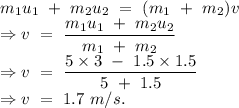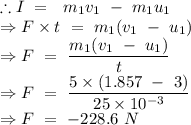
Physics, 21.09.2019 03:30 aaburto1515
A.5 kg air puck moves to the right at 3 m/s, colliding with a 1.5kg air puck that is moving to the left at 1.5 m/s.
1. determine the direction and speed of the pucks' motion if they stick to each other after the collision.
2. suppose instead that the pucks do not stick together. if the 1.5kg puck moves to the right at .231 m/s after the collision, was the collision elastic? provide evidence!
3. determine the size and direction of the average force acting on the .5kg puck during the second collision, if the collision lasted for 25 ms.

Answers: 2
Another question on Physics

Physics, 21.06.2019 23:10
6–55 refrigerant-134a enters the condenser of a residential heat pump at 800 kpa and 358c at a rate of 0.018 kg/s and leaves at 800 kpa as a saturated liquid. if the compressor consumes 1.2 kw of power, determine (a) the cop of the heat pump and (b) the rate of heat absorption from the outside air.
Answers: 2

Physics, 21.06.2019 23:30
Which simple machine is not part of this compound machine? a. lever b. pulley c. inclined plane d. wheel and axle
Answers: 1

Physics, 22.06.2019 02:00
The image shows a pendulum in simple harmonic motion the pendulum starts at a and swing to e
Answers: 3

Physics, 22.06.2019 07:30
Some material consisting of a collection of microscopic objects is kept at a high temperature. a photon detector capable of detecting photon energies from infrared through ultraviolet observes photons emitted with energies of 0.3 ev, 0.5 ev, 0.8 ev, 2.0ev, 2.5ev, and 2.8ev. these are the only photon energies observed. (a) draw and label a possible energy-level diagram for one of the microscopic objects, which has four bound states. on the diagram, indicate the transitions corresponding to the emitted photons. explain briefly. (b) would a spring–mass model be a good model for these microscopic objects? why or why not? (c) the material is now cooled down to a very low temperature, and the photon detector stops detecting photon emissions. next, a beam of light with a continuous range of energies from infrared through ultraviolet shines on the material, and the photon detector observes the beam of light after it passes through the material. what photon energies in this beam of light are observed to be significantly reduced in intensity (“dark absorption lines”)? explain briefly.
Answers: 3
You know the right answer?
A.5 kg air puck moves to the right at 3 m/s, colliding with a 1.5kg air puck that is moving to the l...
Questions


Mathematics, 24.03.2021 05:20

Mathematics, 24.03.2021 05:20

Social Studies, 24.03.2021 05:20

English, 24.03.2021 05:20



Mathematics, 24.03.2021 05:20

Mathematics, 24.03.2021 05:20

Physics, 24.03.2021 05:20

Mathematics, 24.03.2021 05:20


Biology, 24.03.2021 05:20

Mathematics, 24.03.2021 05:20



English, 24.03.2021 05:20

Mathematics, 24.03.2021 05:20

Mathematics, 24.03.2021 05:20

Mathematics, 24.03.2021 05:20

 Mass of the second puck =
Mass of the second puck =  initial velocity of the first puck =
initial velocity of the first puck =  Initial velocity of the second puck =
Initial velocity of the second puck = 


 be the final velocity of first puck after the collision.
be the final velocity of first puck after the collision.





